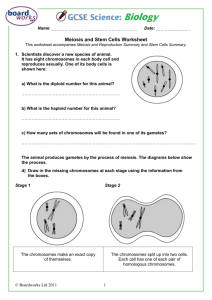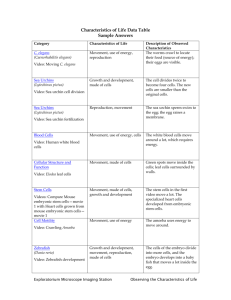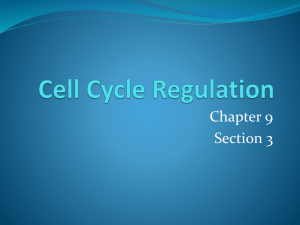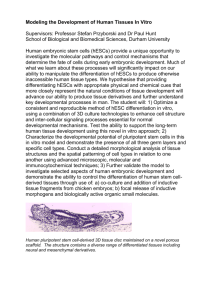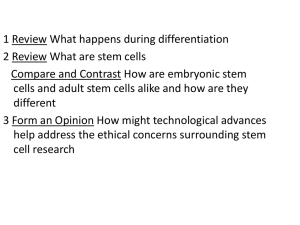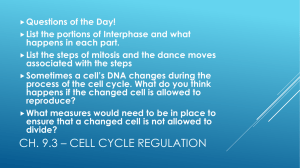Chapter 10 Notes – Mitosis
advertisement
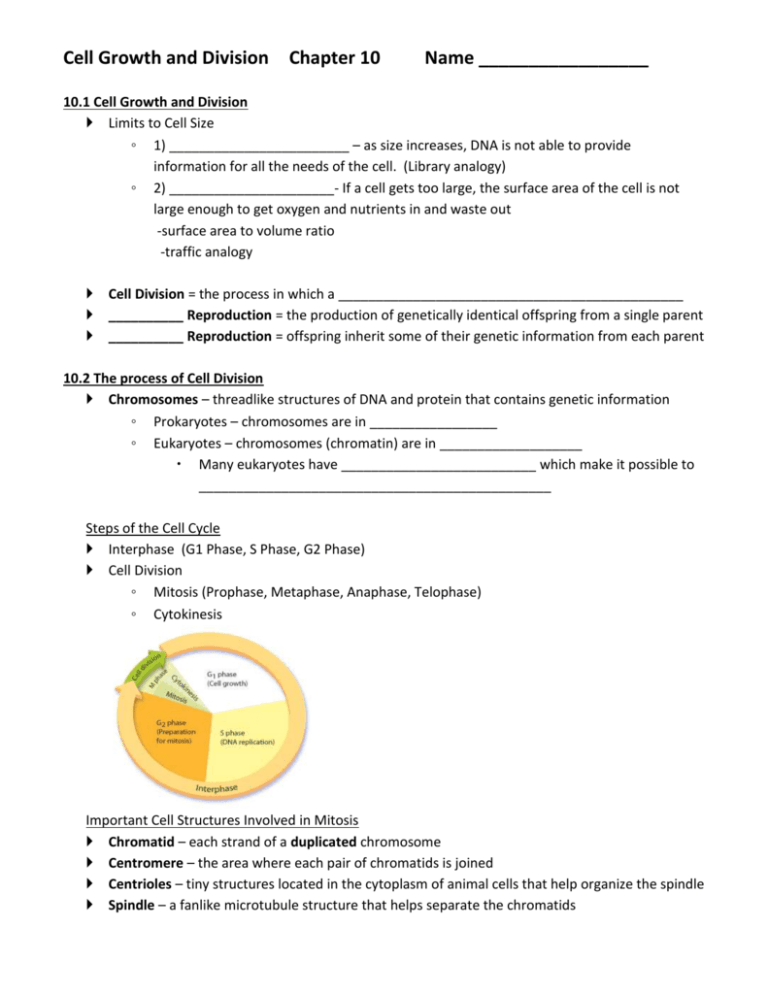
Cell Growth and Division Chapter 10 Name _________________ 10.1 Cell Growth and Division Limits to Cell Size ◦ 1) ________________________ – as size increases, DNA is not able to provide information for all the needs of the cell. (Library analogy) ◦ 2) ______________________- If a cell gets too large, the surface area of the cell is not large enough to get oxygen and nutrients in and waste out -surface area to volume ratio -traffic analogy Cell Division = the process in which a ______________________________________________ __________ Reproduction = the production of genetically identical offspring from a single parent __________ Reproduction = offspring inherit some of their genetic information from each parent 10.2 The process of Cell Division Chromosomes – threadlike structures of DNA and protein that contains genetic information ◦ Prokaryotes – chromosomes are in _________________ ◦ Eukaryotes – chromosomes (chromatin) are in ___________________ Many eukaryotes have __________________________ which make it possible to _______________________________________________ Steps of the Cell Cycle Interphase (G1 Phase, S Phase, G2 Phase) Cell Division ◦ Mitosis (Prophase, Metaphase, Anaphase, Telophase) ◦ Cytokinesis Important Cell Structures Involved in Mitosis Chromatid – each strand of a duplicated chromosome Centromere – the area where each pair of chromatids is joined Centrioles – tiny structures located in the cytoplasm of animal cells that help organize the spindle Spindle – a fanlike microtubule structure that helps separate the chromatids Phases in the Cell Cycle Interphase _____________________________________________ ◦ __________G1 Phase = cell growth, make new proteins and organelles ◦ ____ Phase = New DNA is made (doubles) ◦ __________ Phase = Organelles needed for cell division are made Mitosis = ________________________________________________ ◦ Prophase ________________________ (Chromosomes become visible) Centrioles separate _________________ starts to form ◦ Metaphase Chromosomes __________________ across the center of the cell. Spindle fibers connect the _______________ of each chromosome to the two poles of the spindle. ◦ Anaphase _________________________________ Individual chromosomes are __________________ on spindle fibers ◦ Telophase Chromosomes are at _________________ ends of the cell Chromosomes spread out into ______________________ ___________________________ reforms ___________________ breaks apart ____________ _____________ _____________ _____________ Cytokinesis = _________________________________________________________ ◦ The ______________________ pinches in half ◦ Each of the two daughter cells has an ___________________ set of chromosomes 10.3 Regulating the cell cycle How do cells know when to divide????? ◦ Some cells don’t divide once they are formed (muscle and nerve) ◦ Cells in the bone marrow that make blood cells and digestive tract divide as fast as every few hours ___________________ = a family of proteins that regulates the cell cycle in eukaryotes Regulatory proteins instruct the cells when to divide ◦ Internal regulatory proteins make sure that steps in the cell cycle are completed before the next step occurs ◦ External regulatory proteins direct the cell to speed up or slow down the cycle Ex. Growth factors – stimulate the division of the cell (embryonic development and wound healing) Apoptosis = __________________________________________ ◦ Cells either are damaged and die or they have programmed cell death ◦ In apoptosis the cell and chromatin shrink, cell membrane breaks and other cells recycle it ◦ Ex – mouse foot, human hand Cancer Cancer = occurs when some of the body’s cells ___________________________________ ◦ Cancer cells do not respond to the signals that regulate growth and divide uncontrollably ◦ Cancer cells absorb nutrients needed by other cells, block nerve connections, and prevent organs from functioning. Tumor = _______________________________ ◦ ______________ tumors = noncancerous tumors that do not spread to other tissue ◦ ______________ tumor = cancerous tumor that invade and destroy surrounding tissue ◦ Metastasis = the _____________________________ Causes of cancer ◦ Caused by defects in the genes that regulate cell growth and development Sources of gene defects include Tobacco, radiation exposure, defective genes, viral infection Many cancers have a defective p53 gene which halts the cell cycle until chromosomes have been replicated Treatment of cancer ◦ _________________________ ◦ _________________________ ◦ _________________________ – chemical compounds that kill cancer Targets rapidly dividing cells and also interferes with cell division in normal cells (side effects) 10.4 Cell Differentiation During the development of an organism, cells differentiate into many types of cells. Stem Cells Stem cells = __________________________________________________________________ ________________________ cells= can develop into any type of cell in the body _______________________ = can develop into most (but not all) of the body’s cell types ◦ Inner cells in the early embryo (a hollow ball called a blastocyst) Embryonic Stem Cells ◦ Found in the inner cells mass of the early embryo. ◦ Embryonic stem cells are pluripotent. (cells have the capacity to produce most cell types in the human body) Adult Stem Cells ◦ Adult stem cells are multipotent. They can produce many types of differentiated cells ◦ Adult stem cells of a given organ or tissue typically produce only the types of cells that are unique to that tissue. Stem Cell Research ◦ Repair or replace badly damaged cells and tissues. heart attack stroke spinal cord injuries. Stem Cells – the ethical concerns ◦ Embryonic stem cells are harvested from early embryos Most methods ____________________ the embryo In the past, US limited funding for the embryonic cell lines used for research - NIH has 136 embryonic stem lines in the US that are currently being used for research Research is being done to harvest embryonic stem cells without destroying the embryo turning adult stem cells into pluripotent cells Embryonic stem cells out of umbilical cord blood


